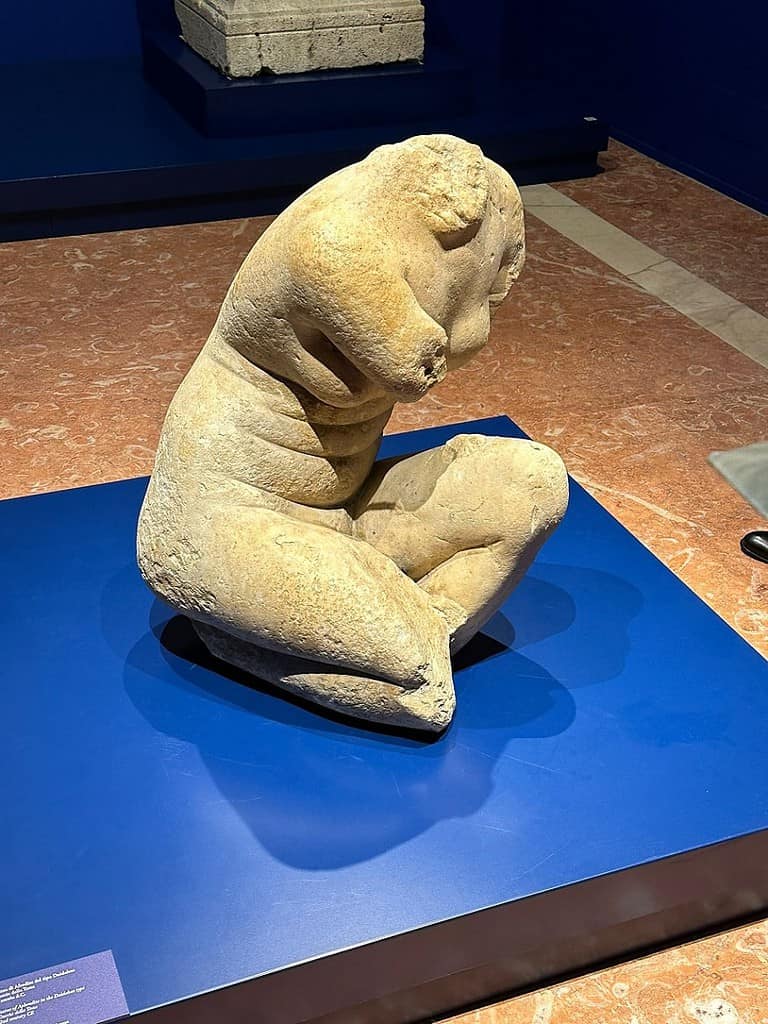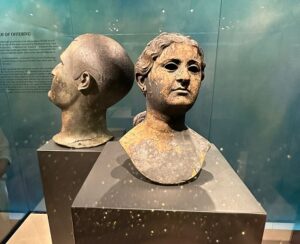The inauguration took place in the presence of the President of the Republic of Italy, Sergio Mattarella, and the Minister of Culture, Gennaro Sangiuliano. For the first time, the extraordinary discoveries made in 2022 in the Etruscan and Roman thermal sanctuary of Bagno Grande in San Casciano dei Bagni were presented to the public.
The exhibition winds like a journey through the centuries within the landscape of the warm waters of the territory of the ancient Etruscan city-state of Chiusi. Starting from the Bronze Age up to the Imperial Age, the great tradition of bronze production in this area of Etruria is presented as a spiral of time and space: like the hot water of the thermal springs it whirls and it becomes travertine, thus the visitor discovers how the bronze offerings meet the water not only in San Casciano but in a multitude of sacred places in the area.
Over 20 statues and statuettes, thousands of bronze coins, and anatomical votive offerings tell a story of devotion, cults, and rites hosted in sacred places where the thermal water was also used for therapeutic purposes.

The exceptional state of conservation of the statues inside the hot water has also made it possible to hand down long inscriptions in Etruscan and Latin which tell of the people who frequented the sacred place, of the deities invoked and of the co-presence of Etruscans and Romans around the hot water.
The discovery of the bronzes of San Casciano dei Bagni is presented in the 7 dedicated rooms of the Palazzo del Quirinale as a journey through the landscape of the warm waters of the Chiusi area. The experience of lightning buried in the sacred pool in the center of the sanctuary, the fulgur conditum, which was perhaps evidence of a prodigy that occurred at the beginning of the 1st century AD at Bagno Grande, introduces the visitor to the encounter with the thermal spring and its sacredness.
On one side is the statue of a female divinity with a dedication in Etruscan to the Flere of Havens, the Nume della Fonte. On the other, a sick – and perhaps cured – ephebe with a Latin inscription testifying to the offer of hot water to Fons, the Source.
Different matrices and inscriptions tell of a welcoming universe, where multiculturalism and plurilingualism were the hallmarks of this sacred place. The Visitor thus finds himself face to face with the ancient dedicates at the sacred tub.
This place of prayer is above all a space for ancient medicine.
Apollo, almost dancing, was placed together with polyvisceral plates and a surgical instrument, testifying to a school of medicine active at the sanctuary. The visit itinerary ends with the explosion of the offer regime.
The last room accompanies the visitor among the portrait heads, both offers and offerers, within the stratification of the sacred basin of the sanctuary. The small bronze statuettes, humans, and animals follow one another.

The world of childhood is represented by the Putto of San Casciano, also dedicated to the Nume della Fonte and by babies in swaddling clothes. The exceptional presence of anatomical ex votos in bronze and not in terracotta (unique in the world in bronze found so far) in San Casciano expands between upper and lower limbs, masks and faces, breasts, genital organs, and ears.
The search for the context and the extraordinary scientific opportunity for research into antiquity offered by this excavation is demonstrated by the vegetable offerings (pinecones, fruit, carved wood, and a comb) placed in the sacred tub.
When in the imperial age the offer became money, from the 1st to the 4th century AD, large nuclei of coins, sometimes freshly minted, sanctioned the life of the sanctuary until it was closed at the beginning of the 5th century AD. From the landscape to the sacred, from hot water to bronzes, the story of the discovery of San Casciano dei Bagni becomes the discovery of the ancient and the possibility of bringing cultural heritage to life.
The exhibition is promoted by the Quirinale and the Ministry of Culture.
@media (max-width: 1200px) {
.ns-buttons.ns-inline .ns-button-icon { width: 100%; } .ns-buttons.ns-inline .ns-button-label { display: none; }
}.ns-inline:not(.ns-columns) .ns-buttons-wrapper {
justify-content: center;
}body .ns-inline:not(.ns-columns) a.ns-button, body .ns-inline .ns-total-share-count {
margin: 0px 5px 10px 5px;
}
Read more: The Gods Return to Italy
Copyright: eTurboNews is Travel Industry News – Travel & Tourism Story Telling Exposed





